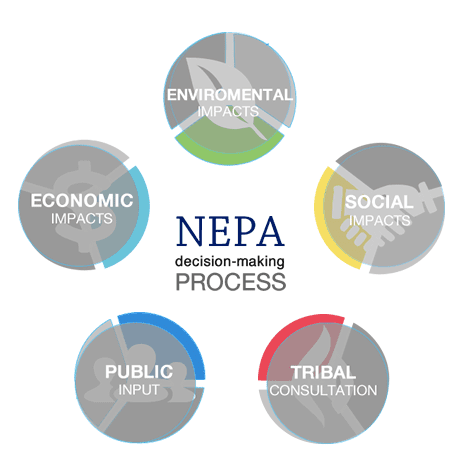By Rachael Lipinski & Mike Swiger
The National Environmental Policy Act (NEPA) requires all federal agencies to analyze the environmental impacts of their actions. The White House Council on Environmental Quality (CEQ) is responsible for developing procedures and regulations for federal agency implementation of NEPA.
Under NEPA, the Federal Energy Regulatory Commission (FERC) must consider the environmental impacts associated with issuing a license for a hydropower project.
In 2020, the Trump Administration CEQ introduced major changes to NEPA’s implementation, intending to streamline the project approval process. Recently, the Biden Administration CEQ reversed several of the most controversial provisions in the Trump Administration’s 2020 Rule. Notably, as the 2020 Rule had not been in effect for long, relatively few NEPA analyses have been conducted under the 2020 Rule.
WHY IT MATTERS
What does the current approach to implementation – in effect as of Friday, May 20 – mean for hydropower? Here are the three big takeaways:
In preparing NEPA documents, agencies:
- May consider agency policies and missions, not just the applicant’s purpose, in stating the purpose and need for the project in an environmental impact statement.
- Will be required to analyze the indirect and cumulative impacts of project proposals, which may be more tenuous than direct effects, but also may include the beneficial effects of hydropower on climate change.
- May develop their own NEPA procedures, which could involve additional environmental factors not covered by the CEQ rules.
THE DEEP DIVE
On April 20, 2022, the White House CEQ published a final rule reversing strategic changes made under the Trump Administration to CEQ regulations implementing NEPA (the “Final Rule”). The Final Rule became effective Friday, May 20, 2022.
The Final Rule largely follows the changes outlined in CEQ’s October 7, 2021, proposed rule, restoring three key provisions to the prior regulations:
- Considerations relevant to the “purpose and need” of a proposed action;
- The definition of “effects,” restoring the prior definitions of direct, indirect, and cumulative effects;
- Agency flexibility to develop NEPA implementation procedures that go beyond the government-wide NEPA regulations.
The CEQ states that it intends the provisions in the Final Rule to have the same meaning as the corresponding provisions in the regulations in effect prior to the Trump Administration’s 2020 “Update to the Regulations Implementing the Procedural Provisions of NEPA,” which is also known as the 2020 Rule.
The Final Rule completes the first of a two-phased process by the Biden Administration to reconsider and revise the 2020 Rule. Phase 2, which is expected sometime in 2022, will take a more comprehensive review of the NEPA regulations.

A DEEPER DIVE: OVERVIEW OF PHASE 1 FINAL RULE CHANGES
The Phase 1 Final Rule includes a narrow set of changes intended to reverse several of the most controversial elements of the 2020 Rule, as highlighted below.
Purpose and Need
The purpose and need section of an environmental impact statement explains why a proposed action is being pursued and provides the boundaries for the range of reasonable alternatives considered.
The Final Rule eliminates language added by the 2020 Rule requiring agencies to base the “purpose and need” of a proposed action on the goals of the applicant and the agency’s authority and makes a conforming change to the definition of “reasonable alternatives.”
In reverting to the pre-2020 Rule purpose and need language, CEQ states that it is eliminating ambiguity that could be interpreted to make the applicant’s goals and the agency’s statutory authority the only factors that agencies can consider when developing a purpose and need statement for environmental review of an application for an agency authorization.
This change will potentially result in more expansive purpose and need statements or reinvigorate litigation challenging purpose and need statements that prioritize an applicant’s goals over other potentially relevant factors.
Agencies also will be free to evaluate alternatives that do not strictly reflect the applicant’s purpose and need for the project but are driven by agency policies and missions.
Definition of “Effects” or “Impacts”
NEPA requires agencies, while undertaking environmental reviews of covered actions, to assess the environmental effects of the proposed action, alternatives, and any adverse environmental effects that cannot be avoided if the proposed action is implemented.
The Final Rule restores the concepts of direct, indirect, and cumulative impacts. CEQ explains that these changes are necessary to “help ensure the proper scope of analysis that NEPA requires, including analysis of effects on climate change, communities with environmental justice concerns, and wildlife.”
The 2020 Rule eliminated long-used concepts of direct, indirect, and cumulative effects, instead focusing the analysis on those effects that are reasonably foreseeable and have a reasonably close causal relationship to the proposed action or alternatives.
The 2020 Rule further provided that a “but for” causal relationship is not sufficient, and that effects generally should not be considered “if they are remote in time, geographically remote, or the product of a lengthy causal chain.”
Although the Final Rule reverses the 2020 Rule changes to the definition of “effects or impacts” by restoring direct, indirect, and cumulative effects as part of the definition of “effects,” the Final Rule recognizes that nothing in the CEQ regulations requires agencies to categorize effects separately as direct, indirect, or cumulative. Rather, CEQ states that agencies can holistically discuss “all reasonably foreseeable direct, indirect, and cumulative effects, rather than delineating the categories in separate sections of a NEPA document.”
In the preamble to the Final Rule, CEQ explains that the revised definition of effects ensures that NEPA reviews consider adverse and beneficial effects, including greenhouse gas emissions, over various time frames. Thus, according to CEQ, air pollution like greenhouse gas emissions released by fossil fuel combustion is often a reasonably foreseeable indirect effect of proposed fossil fuel extraction that agencies should evaluate in the NEPA process, even if the pollution is remote in time or geographically remote from a proposed action.
The consideration of beneficial effects is of relevance to renewable energy project development like hydropower. Using the example of a utility-scale solar facility, CEQ notes that a solar facility could have short-term direct effects (such as adverse construction and land impacts), as well as long-term indirect beneficial effects (such as reductions in air pollution from the renewable energy generated at the facility that displaces more greenhouse gas intensive energy sources like coal or natural gas).
This analysis for a hydropower project would also consider long-term indirect and cumulative reductions in air pollution from energy at the project displacing more emissions intensive energy sources.

Agency NEPA Procedures
The Final Rule removes limitations imposed by the 2020 Rule on the scope of agency-specific NEPA procedures and clarifies that, while agency NEPA procedures must be consistent with the CEQ regulations, agencies also have the discretion and flexibility to develop procedures that go beyond the CEQ regulatory requirements.
This revision will allow agencies to adopt procedures that may go beyond the CEQ regulations as appropriate to address their individual authorities, programs, and circumstances.
WHAT’S NEXT?
Although the Federal Energy Regulatory Committee, as an independent agency, is not bound to follow CEQ’s rules, it generally does so unless it determines they are inconsistent with its own statutory responsibilities.
Other federal agencies with concurrent permitting authority over hydropower development, such as federal land management agencies and the U.S. Army Corps of Engineers, will follow the new CEQ rules.
With the Phase 1 Final Rule now complete, CEQ will continue to work on Phase 2, which CEQ has said will comprehensively consider the 2020 Rule and the NEPA regulations.
Statements in the preamble to the Phase 1 Final Rule suggest that CEQ may use Phase 2 of the rulemaking or additional guidance documents to provide greater clarity on analyses of greenhouse gas emissions, climate change, and environmental justice.
What this means for hydropower is yet to be determined.
Originally appeared in the National Hydropower Association's Powerhouse Newsletter.